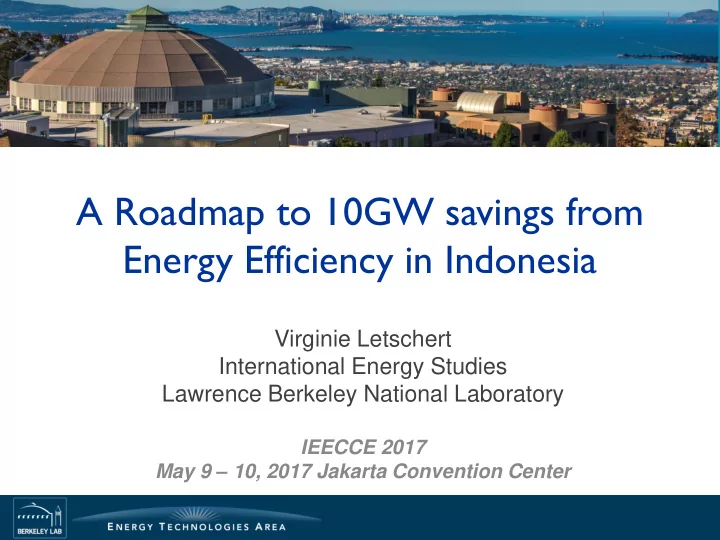

A Roadmap to 10GW savings from Energy Efficiency in Indonesia Virginie Letschert International Energy Studies Lawrence Berkeley National Laboratory IEECCE 2017 May 9 – 10, 2017 Jakarta Convention Center
Lawrence Berkeley National Laboratory Managed by the University of California for the United States Department of Energy “Bringing Science Solutions to the World” • 4,200 employees (>200 UC faculty on staff at LBNL) • ~$820 million annual budget • 13 Nobel Prizes + many members of the IPCC – 2007 Nobel Peace Prize • Buildings energy efficiency including efficiency standards was pioneered by LBNL in the 1970s by Art Rosenfeld and others • Provides technical support to the U.S. Department of Energy’s Appliance Efficiency Standards program (since the late 1980s) • International Energy Studies Group collaborates with countries around the World to support energy efficiency programs.
Clean Energy Ministerial and the Super-efficient Equipment and Appliance Deployment (SEAD) Initiative The Clean Energy Ministerial (CEM) is a forum of the world’s largest and most forward -leaning countries working together to accelerate the global transition to clean energy . High-level political engagement paired with sustained initiatives and high-visibility campaigns to raise political ambition and support clean energy policy and technology deployment. As an implementation forum , CEM will help countries deliver on their clean energy goals post COP21 and build confidence and capacity to increase ambition even further over time. SEAD Initiative is a voluntary collaboration among governments working to promote the manufacture, purchase, and use of energy-efficient appliances , lighting, and equipment worldwide. Government of Indonesia has joined SEAD in July 2014 LBNL provides technical support to the SEAD initiative and other initiatives and campaigns under CEM
EE Policy Global Impacts Most of the remaining potential is in non- Energy Efficiency #1 in GHG Mitigation OECD economies 3.1� Gt� � by� 2020� (80%� of� 2C)� 2030� Electricity� Savings� Poten al� Reduce� 1600� Subsidies� Other� 1400� Reduce� Motors� &� 1200� EE� Transformers� Methane� 1000� Policies� Emissions� Water� Hea ng� TWh� 800� Appliances� 600� Ligh ng� Power� 400� Sector� 200� HVAC� 0� 2010-1014� Half of CO 2 mitigation may come from OECD� Non-OECD� Achievements� Poten al� EE policy. Source: LBNL BUENAS Analysis for Source: IEA 2012 SEAD – BAT and recent savings vs. 2010 baseline
EE in Indonesia : Infrastructure Challenge Indonesia needs 50GW of capacity by 2030 , and will spend $73 bn to get first 35GW by 2019 (mostly thermal), also targeting 23% renewable energy by 2025. We identify over 10 GW savings from EE policy for appliances by 2025 , thus bridging gap for additional capacity needs. Main barriers are technical capacity and financing. EE policy should be fully integrated into any power sector projects , renewable or otherwise Source: LBNL - McNeil et al 2017 (Upcoming Journal Article)
Introduction to10GW Roadmap Minister Luhut’s visit (Sept 2016), LBNL Savings Impact from China S&L presented experience and success stories in EE in major world economies, such as China …followed by delegation visit at LBNL, led by CMMA (December 2016) Objective: Define essential components to achieve target of 10 GW reduction in projected peak power consumption in Indonesia in 2025 and collaborate on technical analysis and capacity building to achieve this. Policy Focus : Appliance efficiency standards focusing on a few high-impact products. Other policies and programs to be added as appropriate.
Where Do Savings Come From? 2025 GW Savings by Product • Biggest demand reduction by far comes from EE air conditioners due to (1) high growth (2) high usage and (3) strong technology opportunity – 7 GW by 2025 • Refrigerators and televisions are a second and third-place - 1.3 and 1.2 GW by 2025, respectively.
1. Understand the Market Capturing the potential – 2. Information & Labeling how to Achieve Savings? 3. Stimulate Research & Dev. 4. Set MEPS 50% 5. Market Pull Mechanisms DSM, Bulk Procurement, Financial Incentives 45% Percentage of Market 40% 35% 30% 25% 20% R&D 15% 10% 5% 0% 4 Stars 3 Stars 2 Stars 1 Star More Energy Efficient Products Less Energy Efficient Products
Pitfalls and Support The opportunity is here, but impacts from EE policy are not guaranteed. Common pitfalls are: • Lack of Prioritization – Focus on small-impact products at the expense of larger ones • Manufacturer Opposition – Industry not clear on or 800 threatened by standards Air Conditioner Market in Indonesia • Lack of Market Knowledge – no insight into product 700 types, efficiency level, cost of efficiency 600 • Lack of Analysis – unclear metrics and methods for Price USD 1 star setting targets 500 2 star • Missing Feedback – Lack of robust evaluation and 3 Star 400 impacts tracking 4 Star 300 International community has recognized these 200 barriers, and develop sets of methods and tools 0 5,000 10,000 15,000 to support countries in the Cooling Capacity Btu/hr development/evaluation of their programs. IDEA Database – upcoming paper for EEDAL Conference
Recommendations & Takeaways Creation of Steering Committee to review existing policies / barriers 10 GW Roadmap implementation lead – ESDM. Coordinating Ministry – Maritimes Affairs (leading Advisory steering committee). Members: BAPPENAS, Ministry of Industry, Ministry of Finance, Ministry of Environment and Forestry, DEN, PLN… Stakeholders engagement: Manufacturers, Consumer Advocates, Environmentalists Institutional Capacity Development through research and collaborations (BPPT, ITB, BSN, Bali Clean Energy CoE, etc) Capacity building for Implementers (testing, evaluators, enforcement, ESCOs, etc ) These will require massive investments in human capacities, financing for manufacturers, users - still very limited compared to current investment on supply side.
Thank you! For more information: https://ies.lbl.gov/ Email: Vletschert@lbl.gov
Recommend
More recommend